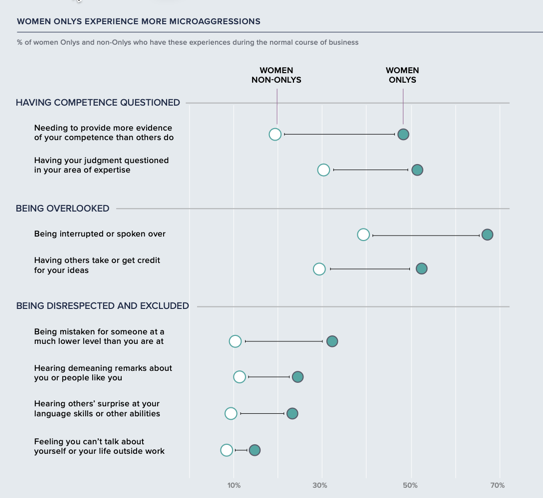
When I was in graduate school, I was the only woman in the department of Computer and Electrical Engineering. At my first job, at an engineering company, out of perhaps 300 engineers, there were 3 women. We became close and were recruited to the company volleyball team because it needed to be co-ed in order to compete in the league. I can go on about the myriad of times I was the only woman in a meeting, group, or department.
I’m part of a group that a new survey from LeanIn.org and McKinsey & Co. calls “Onlys:” women who are often or always the only female in the room at work. This is a common occurrence for female employees in technology, engineering, and management according to Lean In—and that singularity takes a toll.
A new study published by Lean In.org and McKinsey & Company documents the experience – women find themselves in meetings and other workplace situations where they are the only woman. That statistic doubles for women in senior-level positions, 40% of whom report being the lone woman. The data comes from a survey of 279 companies, with 64,000 employees participating. Read the full report here.
Approximately 1 in 5 women say that they are often the Only, and this doubles for senior-level women and women in technical roles. In comparison, about 5 percent of men are often the only or one of the only men in the room. But the Only experience isn’t limited to gender. Being an Only is common for people of color and LGBTQ+ people. Thirty-eight percent of people of color are often the only or one of the only people of their race and ethnicity in the room. Likewise, 68 percent of gay men and 70 percent of lesbian women are often Onlys for their sexual orientation.
Women who are Onlys are far more likely to experience microaggressions than women who work with other women. They are more than twice as likely to be asked to prove their competence, over three times more likely to be mistaken for someone more junior, and about twice as likely to be subjected to demeaning or disrespectful comments. Moreover, they are twice as likely to have been sexually harassed at some point in their career.

from https://wiw-report.s3.amazonaws.com/Women_in_the_Workplace_2019.pdf
We cannot change the situation overnight, but we can work to counteract the Only experience. Some ways to counter this include hiring and promoting women in cohorts, being more deliberate regarding staffing, providing mentorship programs, and creating cross-functional teams. At Healthmonix, we value our employees and their career paths. We do our best to hire with diversity in mind, to forgo unconscious bias and to give all of our employees the opportunity to move into more challenging and rolls with more responsibility.
How many times have you been in a situation where some characteristic about yourself is different than everyone else in that group? Tell us about your experience.

